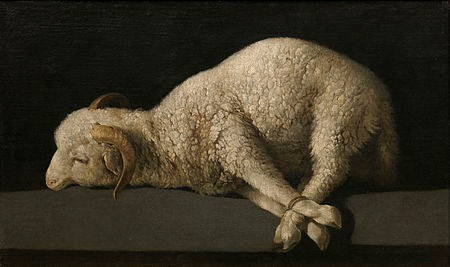Real Presence in the Eucharist
By Father Jeffrey VonLehmen.
In the Gospels Jesus says, “This is my body” and “This is my blood.” What does that mean to each of us?
How is Jesus present in the Eucharist? Most of us, at one time or another, find ourselves either asking that question or trying to explain the mystery for someone else. Catholics believe that the Body and Blood of Jesus are present in consecrated bread and wine. We do not say the Eucharist is like the Body and Blood of Jesus, but that it is the Body and Blood of Jesus.
In the Gospels, Jesus says, “This is my body,” and “This is my blood.” That is strong language. It is language Christians have sought to understand for many centuries. In the Eucharist, we proclaim the mystery of faith. And it is a mystery! But the mystery of the kingdom of God and the Eucharist is meant to be obvious although it cannot be reduced to human logic. Sometimes, what is most obvious is most overlooked.
I invite you to look at the obvious — our ordinary human experiences — to help make sense of the Eucharist and Real Presence. Why does it make sense for Catholics to believe in what traditionally has been called transubstantiation (the changing of the whole substance of the bread and wine into the Body and Blood of Christ)? Why is it important to say that the Eucharist is a concrete encounter of the community with Jesus and not just a spiritual thing between an individual and God? In our own human experience, we can discover why real presence and the body-and-blood presence of Christ are important to us and to God.
Flesh and Blood Relationships
We often think of spiritual as invisible. But who wants an invisible relationship with a loved one?
Consider this example. A father leaves work early on a weekday, drives five hours to another city to be present at his son’s college basketball game, and then drives home the same night. The father arrives home about 5 a.m., catches an hour of sleep, and then goes to work.
He does this often. Perhaps it would be enough to tell his son over the phone that he is thinking about him and cheering and praying for him. But think how much more it means to the child that his father is not just there in spirit — he is there in flesh. He is providing real presence for his son. What a big difference!
When we love someone, we want a concrete relationship, and the loving Spirit of God always seeks a body-and-blood relationship with us. That’s what we celebrate in the Incarnation at Christmas and in the death and resurrection of Jesus on Good Friday and Easter.
The Spirit dwells in us so we might experience God, who wants a real relationship with us. We need a body-and-blood relationship with God in Christ. Yet we can only begin to understand the body and blood of Jesus when we understand true love in relationships involving friends, family and marriage.
Sacrifice and Life
Think in terms of word associations. When I say “green” someone might think of grass. When I say “blue,” one might think of the sky. In our culture, when someone says “blood,” we probably think of something terrible, of violence or loss of life. When we hear about body and blood as sacrifice, as in the sacrifice of the Mass, we think somebody or something has been killed. But in the ancient Hebrew mentality, if an animal was sacrificed to God, the people did not think the animal was killed to appease an angry God. Instead, they thought of blood as the presence of life. Sacrifice was not so much giving up their best lamb or the first and best part of their crop. Sacrifice meant communion of life.
This brings to mind the wonderful image of an infant in the mother’s womb. The infant is being nourished through the umbilical cord by the body and blood of the mother. The baby is receiving life! The mother’s body is making all kinds of changes and sacrifices for the infant in her womb, and the mother is very conscious of the communion she has with her infant. The bond between mother and baby is truly a body-and-blood relationship.
The bond between God, our loving parent, and us is just as strong and concrete. God wants a body-and-blood relationship with us, and this concrete relationship is made possible in Christ. God so loved the world that he sent his only Son. Christ’s sacrifice in becoming one like us in the Incarnation and in his passion on the Cross establishes a communion of life, a real presence in which we are assured that God desires us as much as we desire him.
The bread and wine are not simply like the body and blood of Christ they are the body-and-blood presence of Christ. This is because our relationship is that concrete, that real, that wonderful! Jesus is God revealing God’s self to us. Neither God nor we want an invisible relationship — we want the real thing!
We can increase our understanding of God’s presence during the Eucharistic prayer and Communion by thinking about being in the womb of God where we are fed concretely through the umbilical cord of the Holy Spirit.
Demonstrating the importance of this sacrament, a Catholic visionary once said, “If I had a choice between a vision and the Eucharist, I would choose the Eucharist.” Truly the Eucharist is a real, interpersonal encounter between God and the worshiping community precisely because Christ is body-and-blood present. Our human experiences of love and relationships tell us that any lover seeks concrete union with the beloved.
The love expressed in the Eucharist is as old as Christmas. It is like the love between a mother and her infant in the womb. It is the love of God in Christ for his people not yet fully born into the reign of God: ” … the bread that I will give is my flesh for the life of the world, … Whoever eats my flesh and drinks my blood has eternal life, and I will raise him on the last day. For my flesh is true food, and my blood is true drink.” (John 6:5l-56)
The Different Modes of Christ’s Presence
In order that they should achieve a deeper understanding of the mystery of the Eucharist, the faithful should be instructed in the principal ways in which the Lord is present to his Church in liturgical celebrations.
He is always present in a body of the faithful gathered in his name (see Matt 18:20). He is present, too, in his Word, for it is he who speaks when the Scriptures are read in the Church.
In the sacrifice of the Eucharist he is present both in the person of the minister, “the same now offering through the ministry of the priest who formerly offered himself on the cross,” and above all under the species of the Eucharist. For in this sacrament Christ is present in a unique way, whole and entire, God and man, substantially and permanently. The Sacred Congregation of Rites, instruction on the Worship of Eucharistic Ministry, sates that this presence of Christ under the species “is called ‘real’ not in an exclusive sense, as if the other kinds of presence were not real, but par excellence.” (Sacred Congregation of Rites, instruction on the Worship of Eucharistic Ministry, no.9)
The Body of Christ
There is no doubt that a body-and-blood relationship exists between a mother and her child. But they don’t think of each other as body and blood. They think about the human relationship between them, whether or not it is a mutually loving relationship. It’s the same way in the Eucharistic celebration. We have a body-and-blood relationship with God in Christ. In this encounter, we no longer get stuck on the elements of bread and wine, Body and Blood. This is because we experience persons instead of things, relationships instead of magic. Real reverence has to be for the person of Christ and for all people for whom he died — the two are inseparable. That is why people are called the body of Christ.
We cannot have reverence for the Body and Blood of Christ — the person of Christ — if we knock down those for whom he died out of love. For this reason, people are the body of Christ. Scripture always says it so well: “Amen, I say to you, what you did not do for one of these least ones, you did not do for me.” (Matt 25:45) “If anyone says, ‘l love God,’ but hates his brother, he is a liar.” (1 John 4:20) In speaking of the condemnation of the unjust steward, Matthew’s Gospel says, “So will my heavenly Father do to you, unless each of you forgives his brother from his heart.” (Matt 18:35)
It is simple: we must have reverence for one another. We cannot help but want a community of compassion, mercy, peace and justice. We recognize that we all come form the same womb of God, the love of God poured out into our hearts through the outpouring of the Holy Spirit signed and sealed in the body-and-blood relationship we have in Christ.
Father Jeffrey VonLehmen is pastor at St. Patrick Parish, Taylor Mill.



